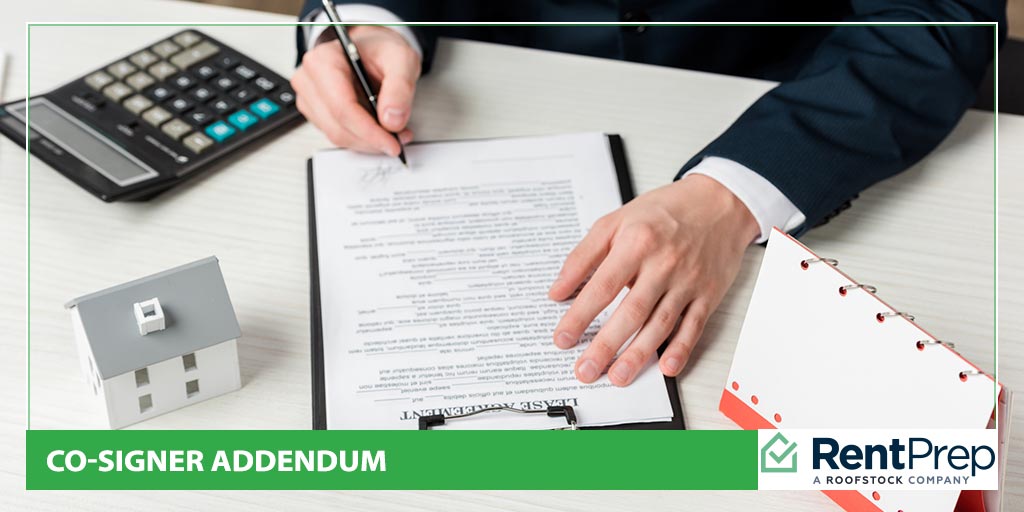
Not every potential renter has the financial record that you had hoped they would have. Sometimes, great people don’t have a strong enough monetary background to make you feel confident in renting to them. Does this mean that you have to turn them away?
The decision to rent to them or not is ultimately up to you, the landlord, but there is another way that you can make it possible to rent to tenants with a rocky past. You can use a co-signer addendum.
While not all landlords like this type of document, some find that it gives people a second chance in a relatively safe way, and that can make all the difference. Let’s learn more about co-signer agreements and how you can create your own document using our sample template.
A Table Of Contents For Co-Signer Agreements
- What Is A Co-Signer On A Lease?
- When A Co-Signer Agreement Is Necessary?
- Co-Signing A Lease: Responsibilities
- Sample: How To Use Our Co-Signer Agreement Template
- Is A Co-Signer Agreement Right For You?
What Is A Co-Signer On A Lease?
A co-signer addendum is a document that can be added to a standard rental agreement to add the protection of a secondary party that will be responsible for the lease in addition to the tenant that is signing the primary rental agreement.
This second party person is known as the co-signer for the lease. Usually, the co-signer is someone that has more financial security and responsibility than the primary tenant. Since they have a stronger financial history, the landlord can rely on receiving payment even if the primary tenant isn’t as reliable.
This signed document proves that the co-signer has agreed to cover any financial problems should the primary tenant be unable to do so for any reason. Additionally, it ensures that both parties are in full agreement about using the document.
When A Co-Signer Agreement Is Necessary?
If you’ve never encountered this situation before, you might be wondering when the co-signer lease agreement might be used. There are a few situations when having a cosigner for rent protection is a good idea for landlords.
Unemployed Tenants
 If you are planning to rent to a tenant that is unemployed, you might have some questions about their ability to make payments regularly and on time. Even if they can show you some proof of their funds, the fact that they do not have a steady income can make it difficult to feel secure in your choice to rent to them.
If you are planning to rent to a tenant that is unemployed, you might have some questions about their ability to make payments regularly and on time. Even if they can show you some proof of their funds, the fact that they do not have a steady income can make it difficult to feel secure in your choice to rent to them.
In this case, renting to someone with the help of a secondary co-signer agreement is a great way to bring in backup financial security.
Poor Credit
As you know, credit is a big part of the rental industry. Most landlords take a tenant’s general credit score into account when they are determining whether or not they should rent to that applicant. Sometimes, tenants who seem great have bad credit.
What should you do when you like the applicant but you don’t like their credit score? For some landlords, they’ll move on to another applicant immediately. If you’re willing, however, you can take another route.
Ask the tenant why their score ended up this way and see if they are willing to give you some sort of reasonable explanation or proof that they have changed their ways. If you feel that the tenant is relatively reliable after all, you can ask them if they can have a co-signer join in with a co-signer lease addendum.
The added security of this document will help both you and the tenant feel secure in the agreement.
No Credit
Do you plan to rent to students in a college area? Are you renting in an area where a lot of young people are employed?
If so, it is possible that you will come across some applicants that have no credit history because they haven’t had the chance to build it up yet. For landlords working in these types of areas, using the co-signer lease agreement is an essential step in getting their properties rented out in a timely manner.
As the tenant cannot guarantee or prove their responsibility, it is essential to bring in someone else like a friend or family member that can guarantee that financial responsibility in case the applicant is not able to follow through on the lease agreement.
Co-Signing A Lease: Responsibilities

A co-signer for a rental agreement might wonder what type of responsibilities they will have if they decide to sign the document. While the specific responsibilities would depend on the terms listed in the addendum, there are few usual items:
- Co-signer will pay rent and other costs if the tenant is unable
- Co-signer will not move into the property, even if they have to cover such payments
- Co-signer will be responsible for liabilities and associated fees as well
The document that exists between you, the tenant, and the co-signer will only address financial and legal matters between all three parties. If the co-signer and tenant want to have another agreement between themselves to ensure the responsibility is properly managed, that document should not involve you in any way.
All liability should be laid out clearly for the tenant and their co-signer in the addendum. It benefits both you and them to have the information explained as clearly as possible, so be sure to take a close look at our template and ensure your document meets the same standard.
Sample: How To Use Our Co-Signer Agreement Template
Now that you know more about when and why landlords use a co-signer addendum, let’s help you figure out how to set up your own.
To make this process easier, we have a sample template that you can use to get started:
| Co-Signer Addendum |
For many situations, this template will be all that you need to get a co-signer agreement in place. To be sure that you have everything that you need in order, however, let’s break down the sections of this template and why you need each part.
Identifying Information
As always, these documents should start with all identifying information for the tenant, co-signer, property, and date being listed out. While all parties involved are familiar with these details, you are creating a permanent record of the agreement. Every piece of information must be accurately recorded to ensure the document is thorough and legal.
Specific Party Identification
While you have already listed who is involved in the addendum, it’s important to make a very clear statement about who is involved and what roles they play in the agreement. We suggest using a statement like this one:
- This addendum is between the landlord (your name) of the premises, (location address), and the co-signer for the tenant (tenant’s name).
Co-Signer Terms
The next section should specifically lay out what the co-signer is agreeing to. This section should be discussed and reviewed together to ensure that all parties have a full understanding of what is being signed into reality.
Specifically, be sure that your terms include the following:
- The co-signer agrees to all lease terms that have been/will be signed.
- The co-signer agrees to not occupy the property, even if they have to pay costs or fees.
- The co-signer is responsible for the financial obligations of the lease if the tenant does not pay them.
- The co-signer understands that both the tenant and the co-signer are responsible and liable for the lease terms.
You can modify these statements as needed to ensure that the coverage provided by the document fits your situation. However, it’s always important to keep this type of documentation as clear and concise as possible. If there ever is an issue with the agreement, you don’t want your case dismissed because of flowery language used in the agreement.
Signatures
As with most co-sign situations, this form must be notarized when it is signed. The only two parties that need to sign the addendum are the landlord and the co-signer, but it is suggested that the tenant be present to ensure they have a full grasp of what type of responsibility their co-signer is taking on for them.
Is A Cosigner Agreement Right For You?
Once you gain some experience using a co-signer addendum, you’ll find that there are some situations when using it might appeal to you. Still, using this type of document is not a requirement. There may be times when a tenant requests this option to make their application more appealing, but that request does not mean that you have to accept.
There are, of course, benefits to using it. With this form, you may be able to rent out a property quickly rather than spending a lot of time and money to find a more financially secure tenant. Additionally, you have the added security of two parties in case anything should go wrong at the property.
Ultimately, however, it is up to you to make the final call.

